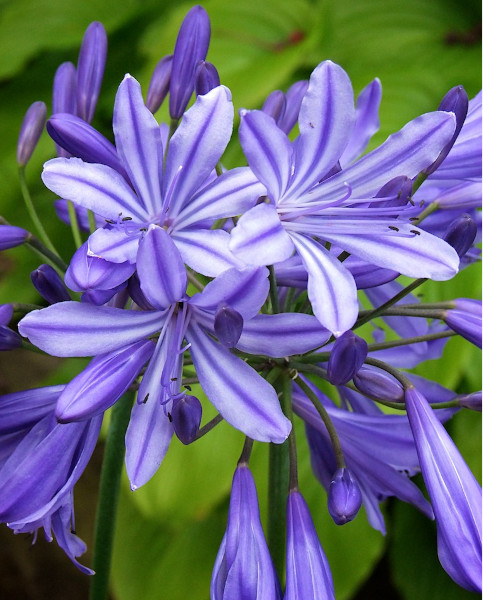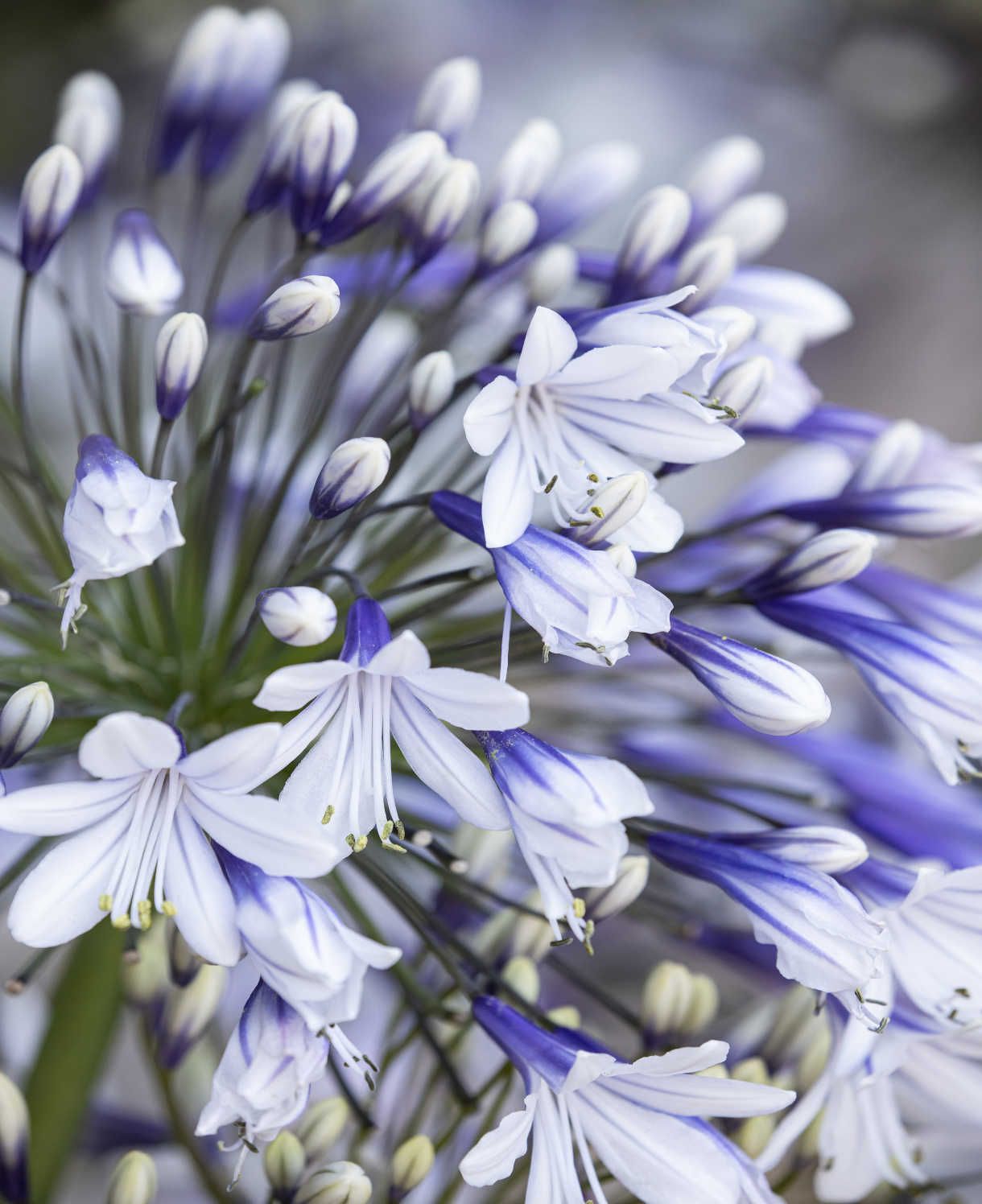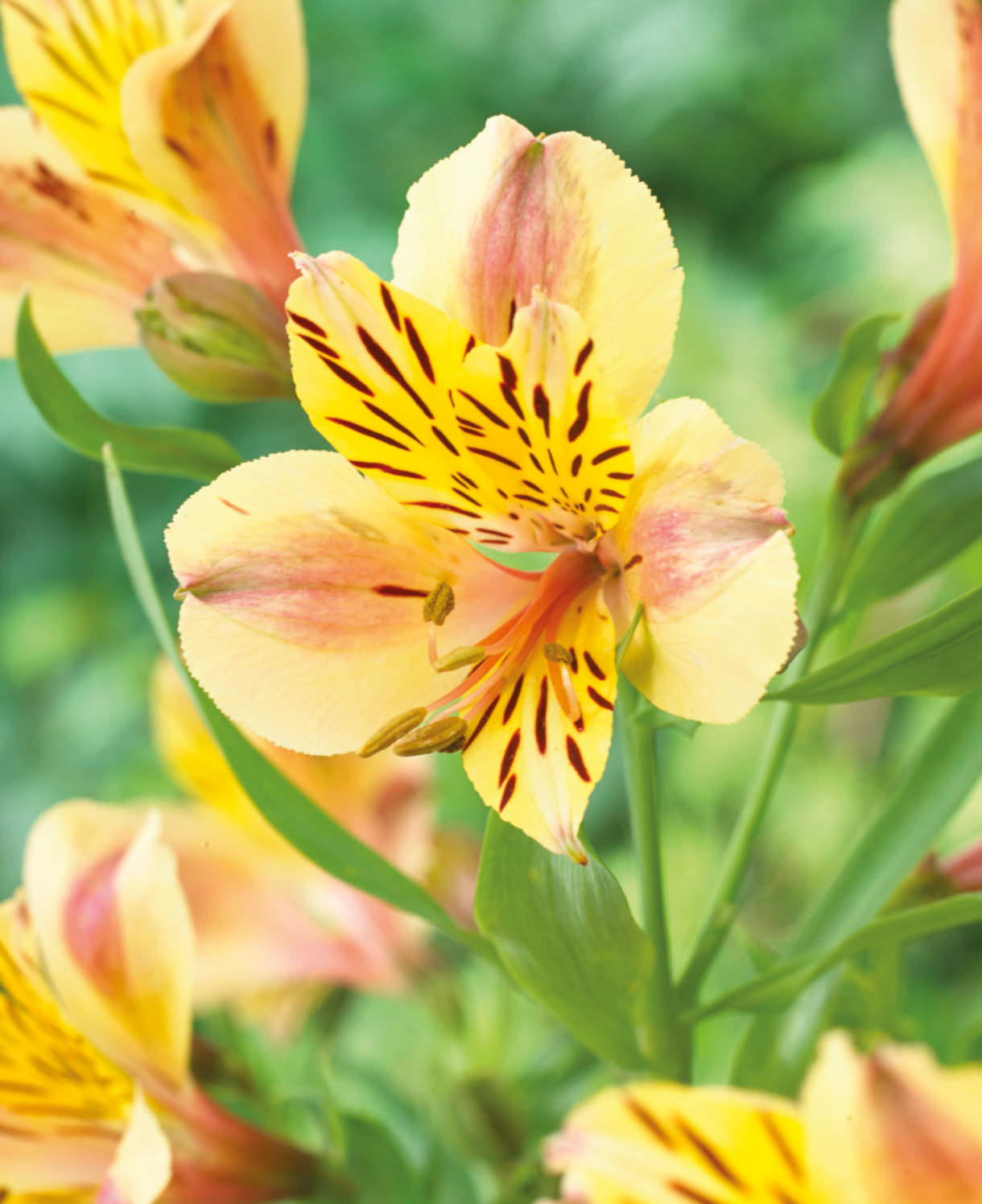How to grow Agapanthus
Often known as African Lilies or Lily of the Nile, Agapanthus hailf from southern Africa, and are usually found in beautiful shades of azure blue, matching the shade of the sky on a clear summer’s day – they make a real impact in the garden, particularly in pots.
A genus of around 10 species of perennials cultivated for their dramatic, spherical flowerheads. They form bold clumps of strappy leaves, and from midsummer onwards bloom in shades ranging from inky dark purple to the palest blue, crisp white and there are even bi-coloured cultivars such as the award-winning Agapanthus Fireworks, a real showstopper!
Agapanthus can be evergreen or deciduous. In their native habitat the evergreen species occur throughout coastal areas and tend to be less hardy, and need winter protection when grown in the UK. Deciduous species occur in moister, mountainous inland regions. These are usually hardier, and tend to be used for outdoor growing in UK gardens.
Agapanthus make great cut flowers, lasting up to two weeks in the vase if you can bear to snip them from the garden! The seed heads also add interest and texture in the borders and can be left to fade on the plants.

Key Information
Soil pH
Position
Hardiness


Where & when to plant Agapanthus
Hardy varieties
For best results plant these in spring, either into a large container or the ground. If your soil is heavy and is prone to waterlogging, we recommend opting for a container.
Agapanthus range considerably in height, so do check the individual description to help in the choosing of an appropriate spot. Shorter varieties are useful for edging a path, using at the front of a border, or as part of a container display. Taller versions are better towards the middle or back of a border.
Half-hardy and tender varieties
These are best grown in containers so that they can be overwintered in a covered, protected environment.
We recommend potting up into a large container on arrival, and keeping in a cool, frost-free environment (such as an unheated greenhouse, conservatory, or cold frame), until all risk of frost has passed and it is safe to move them outside. This is usually mid to late May.
How to plant Agapanthus
In the ground
If you are growing your plants directly into the ground, find a planting spot which receives full sun and dig a hole slightly deeper and wider than your potted Agapanthus. Add a generous layer of sharp grit to the bottom of the planting hole. Next, add some organic matter in the form of homemade compost, well-rotted cow or horse manure, or a handful of chicken-manure pellets to help your young plants off to a great start.
Gently tease your Agapanthus from its pot and loosen the fleshy roots carefully before placing in the ground with the crown of the plant just below the surface of your soil.
Backfill around the plant with soil and firm around the base gently before watering in well. Keep young Agapanthus watered until they have established themselves.
If you are growing your Agapanthus in pots, choose a large pot such as Hayloft’s large Blue Provence Planter and half fill it with a loam-based compost with added grit and crocks in the base for drainage. Plant your Agapanthus in the same way as you would in open ground and ensure the pot does not dry out.
In a container
Choose an appropriate container, ensuring there are plenty of drainage holes in the bottom. Agapanthus like to be cosy in their container; neither overpotted, nor (contrary to popular belief) with their roots overly restricted.
We recommend starting small (the top diameter a couple of centimetres larger than the current spread of the plant) and moving up every two to three years by increments of 2-3cm. When the plant has reached a size at which potting up is no longer feasible, consider dividing (in spring) and starting again.
Use a good quality potting compost with plenty of horticultural grit mixed in, and, if not already present in the compost (check the description on the bag) some slow-release fertiliser granules. Start by partially filling the pot with compost; enough so that when placed on it the upper surface of the root ball is about 3cm lower than the top of the pot.
Infill all the space surrounding the root ball with compost, firming down with your fingers then adding a little more so the plant is held tight. Pick up the pot (if you can!) and lightly tap on the potting bench or ground a few times to help further settle the compost around the plant.
Soak well with water.
A mulch with horticultural grit will look attractive and help to prevent a ‘cap’ or crust forming on the top of the compost (something container plants can suffer due to the artificial nature of their watering).

What to plant with Agapanthus
Large globes of Agapanthus in full bloom in summer look stylish in large containers or terracotta pots. The simplicity of these plants on their own lends them well to modern gardens and contemporary schemes where they fit well with lots of foliage and white plants.
Agapanthus also grow well in coastal areas where their colours are complimented by the sea and sky.
Please contact our helpful and friendly Customer Care Team at Hayloft if you need any further growing tips or help with your Agapanthus plants.
We have a few suggestions below for great plants to accompany your Agapanthus.
Ornamental grasses, Helenium, Coreopsis, Achillea, Box, Cosmos, Verbena bonariensis, Allium sphaerocephalon, Rudbeckia, Lavender, Astrantia, Echinacea, Salvias, Penstemon, Monarda, Veronica, Perovskia, Echinops, Alstroemeria



How to care for Agapanthus
Pruning and Deadheading
Deadhead spent blooms to encourage the formation of more. If you wish to enjoy the seedheads as a decorative feature over winter, cease deadheading towards the end of the flowering season.
Agapanthus does not require pruning other than the tidying away of withered foliage in spring. Try to resist the temptation to do this any earlier, as it provides a useful source of added insulation to the crown of the plant over winter.
Watering
Agapanthus needs plenty of water, particularly when grown in pots. A period of drought, especially during late summer, can be detrimental to the following year’s flowering.
We therefore recommend watering container grown agapanthus freely in the growing season, and sparingly in winter.
In the ground, water agapanthus regularly until established, then in dry spells thereafter.
Cold Protection
Hardy varieties can survive the average UK winter outside with no added protection. However, as with all plants, those grown in containers can be more susceptible to cold damage, and so may benefit from a layer of thick, dry mulch such as straw or bark chippings. You may also wish to wrap containers in fleece or hessian.
Half-hardy varieties are best grown in containers and moved to a cool, frost-free environment over winter. An unheated greenhouse, conservatory, or cold frame all work well.
Pests and Diseases
Snails and slugs can be an issue on the leaves of agapanthus, particularly in early summer and after heavy rain.
Encouraging natural predators into your garden, such as birds, frogs, toads, and hedgehogs, will make a big difference. Torchlight searches after dark (when slugs and snails are at their most active) are also effective, allowing you to collect the offending molluscs in a bucket. Place on the compost heap, or in a part of the garden containing less vulnerable plants.
Like most plants, once agapanthus is well established it tends to be better able to tolerate the actions of slugs and snails without the need for intervention.
How to propagate Agapanthus
If you have an established clump of agapanthus, division is the quickest method of propagation and will provide you with several new, good-sized plants. This is best done in spring.
For agapanthus in the ground
- Choose a day when the soil is not frozen or waterlogged.
- Dig the plant out of the ground.
- Shake off any excess soil.
- Separate the plant into sections using either swift, cutting blows with a sharp spade, or two forks inserted back-to-back with tines touching, handles then pushed together to prise the plant apart.
- Discard old, damaged, or surplus pieces, keeping healthy, vigorous material.
- Replant selected pieces where desired.
- Water well until fully established.
For container grown agapanthus
- Remove from the container by holding it upside down and tapping the edge on a potting bench or table. This should loosen the root ball enough for it to be turned the right way round and lifted out. For very large, congested, or pot-bound clumps, the container may need to be broken apart in order to remove the plant.
- Shake off any excess compost.
- Separate the plant into sections using either swift, cutting blows with a sharp spade, or two forks inserted back-to-back with tines touching, handles then pushed together to prise the plant apart. If plants are very congested, a sharp, serrated knife may be required.
- Discard old, damaged, or surplus pieces, keeping healthy, vigorous material.
- Repot selected pieces (as above in ‘How to plant agapanthus’ → ‘In a container’).
- Water freely in growing season and sparingly winter.
Common Agapanthus questions
- Do agapanthus need feeding?
Agapanthus is a hungry plant which will benefit from the provision of additional nutrients. In the ground this can be an annual mulch of well-rotted organic matter. In containers, a monthly application of balanced liquid feed throughout spring and early summer will boost flowering. - Will agapanthus grow in the shade?
Agapanthus prefers a sunny spot and is unlikely to flower well in shade. - Do agapanthus make good cut flowers?
They do. Agapanthus flowerheads have strong, straight stems and a vase life of up to a week.




